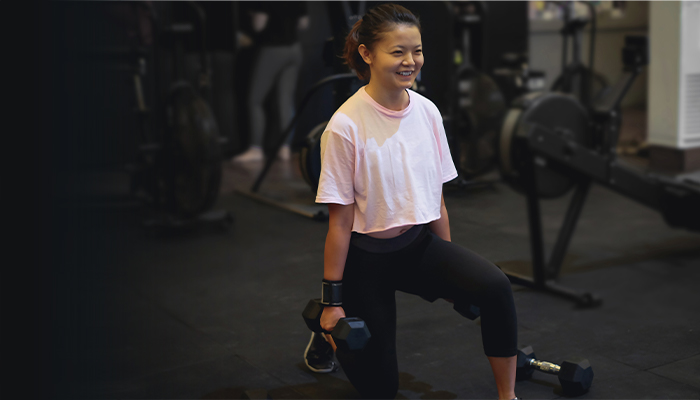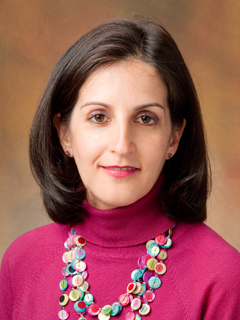HOW CAN WE HELP YOU? Call 1-800-TRY-CHOP
In This Section
Looking to Enhance Lifelong Health in Young HCT Survivors by Focusing on Muscle

Muscle health is an important predictor of long-term health.
Muscle health is an important factor in long-term well-being. Research shows having poor muscle health is a strong predictor of compromised health, resulting in increased morbidity and mortality. Take for instance adolescents and young adults who undergo hematopoietic cell transplantation (HCT) as the curative option for their leukemia. They may experience endocrine late effects after cancer treatment, which puts them at an especially high risk of losing skeletal muscle mass that occurs earlier than would be expected from advancing age alone. Not only does this double their risk for non-relapse mortality, but it also leads to premature cardiovascular disease.

Sogol Mostoufi-Moab, MD, MSCE
“We’ve learned a lot about how to help these patients survive a bone marrow transplant,” said Sogol Mostoufi-Moab, MD, MSCE, an attending physician at Children’s Hospital of Philadelphia whose clinical and research program is focused on endocrine late effects after childhood cancer therapy. “We get them through a transplant, with a growing number of these survivors with late effects. And that’s the group we’re worried about. While they may appear fine physically on the outside, when more carefully evaluated medically, they have muscle loss that is long lasting. It foreshadows a lot of worrisome things.”
Prescribing exercise may seem like an obviously good thing to do, but the details of what is known and what is currently being done regarding exercise in this population is unclear. There is much to be learned, according to Shana McCormack, MD, MTR, an attending physician who investigates the intersection of neuroendocrinology and metabolism.
With a grant from the National Cancer Institute and generous donor support, Drs. Mostoufi-Moab and McCormack will lead a multisite, multidisciplinary clinical study called IAMFIT to test an exercise intervention and exercise mimetic, a supplement that mimics or enhances the beneficial effects of physical exercise. Their goal is to rigorously collect data, keep people as safe as possible, and thus answer the question: Can this individualized exercise prescription alone or in combination with this exercise mimetic improve muscle health in a way that will lead to better lifelong outcomes for our patients?
“Dr. Mostoufi-Moab is focused on oncology and endocrinology,” Dr. McCormack said. “I’m an endocrinologist and do a lot of research with metabolism and neurology. We have exercise physiologists who oversee the exercise, cardiologists who think about the relationship between peripheral muscle health and cardiovascular health, physical therapists who think about strength assessments and exercise assessments. It takes a whole community of folks to put this type of project together.”
Bridging the Lifespan
The study specifically addresses the NCI’s request for research that bridges the divide between pediatric and adult patients. City of Hope Medical Center in California, the largest transplant center in the country, will help CHOP with the young adult group of individuals in their 20s.
“Because the patients we care for at CHOP get diagnosed in childhood or adolescence, and then grow into young adulthood, I think it’s really exciting that we capture the younger kids and we work with our teammates who care for the young adults,” Dr. McCormack said.
The team plans to recruit 80 patients (50 at Hope, 30 at CHOP) between the ages of 15 and 30, who had acute lymphoblastic leukemia that required a bone marrow transplant. The primary outcome of the study is the change in muscle strength (isometric knee extension) from baseline to the end of the study.
The individualized exercise plans delivered remotely through an iPad and overseen by an exercise physiologist from St. Jude’s Children’s Research Hospital in Tennessee, will consist of at-home training sessions of aerobic (stationary bike) and strengthening designed to progress participants gradually to the equivalent of moderate aerobic activity and twice weekly strength training exercises.
While the exercise component is an exciting aspect of the study, the other intervention the researchers are investigating is a supplement called nicotinamide riboside (NR), a form of vitamin B3 that is termed an exercise mimetic — like exercise, NR may increase the availability of a metabolite called nicotinamide adenine dinucleotide (NAD+), a chemical that is important for muscle metabolic health and production of energy.
Study Methodology
The 16-week, randomized clinical trial has a two-by-two factorial design that divides participants into four groups: in-home exercise and the active NR supplement, no in-home exercise and a placebo supplement, in-home exercise and the placebo supplement, or the active NR supplement with no in-home exercise. If they haven’t been randomized to receive the exercise initially, participants will have the chance to do the exercise intervention following the 16-week trial, “because we feel so strongly that folks should have the opportunity to participate in exercise and because that’s the motivation behind a lot of participants who might be enrolling or the clinicians who might be referring them,” Dr. McCormack said.
By having four groups, the researchers get to examine not only the effects of each intervention by themselves but also in combination. They aim to answers questions such as: What’s exercise doing? What is this exercise mimetic doing? Could they potentially be working together to do even more for participants? And then they can compare those data to the group that gets neither.
For the participants randomized to exercise, the St. Jude’s exercise physiologists will use baseline data obtained from a study participant’s initial assessment to design a personalized exercise plan, such as ride 15 minutes on the bike, three times a week, and try to reach a specific goal range with the heart monitor. At specified intervals, if the data shows the patient is regaining strength, the physiologist will adjust their plan so that the participant is increasing the exercise.
It’s critical study participants are adequately recovered from their transplant to safely participate in physical activity, therefore the intervention window is six months to two years after the individual’s transplant. But the earlier the intervention takes place the better, the scientists said, because as soon as these individuals with cancer go through transplant, they can start losing muscle mass.
“We want to go earlier with an intervention so that it, hopefully, is preventing or improving the loss of muscle that they’ve had, in order to prevent that trajectory of severe loss,” Dr. Mostoufi-Moab said.
For more information on IAMFIT, please contact IAMFIT@chop.edu.
